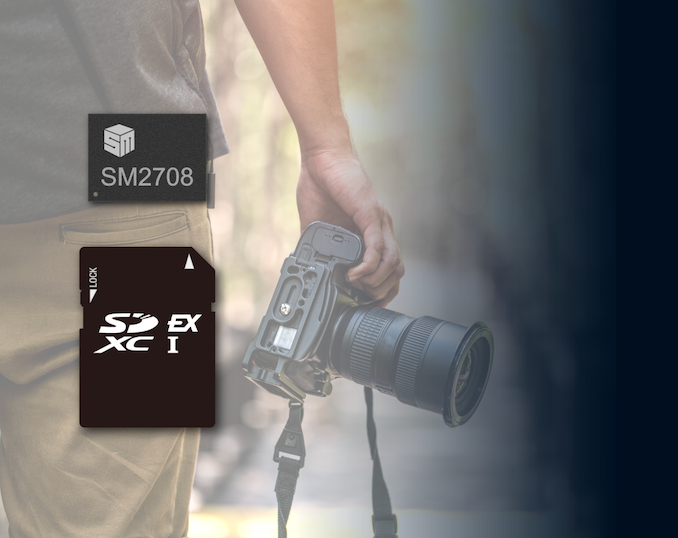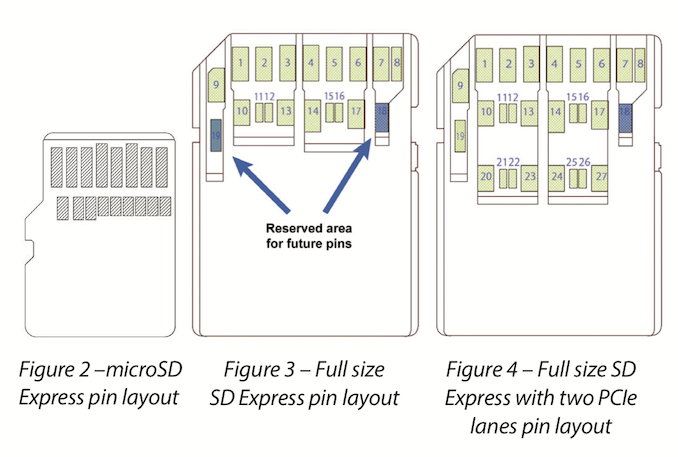Silicon Motion Announces SM2708 SD Express Controller
by Billy Tallis on April 7, 2021 4:30 PM EST- Posted in
- SD Express
- Storage
- SD cards
- NVMe
- Silicon Motion

Silicon Motion has announced their first SD Card controller to support the NVMe-based SD Express interface. The new SM2708 controller is capable of sequential transfer speeds of 1700 MB/s, vastly higher than the 104 MB/s most SD devices and cards are limited to using the older but widely-supported UHS-I interface.
In 2018, version 7.0 of the SD specification introduced the PCIe and NVMe-based SD Express interface as the new way forward for SD cards. The older UHS-II and UHS-III interfaces developed in versions 4 through 6 of the SD standard and capable of speeds from 156 MB/s to 624 MB/s were abandoned in favor of a single lane of PCIe gen3 (~985 MB/s). Last year, version 8.0 of the SD specification added support for PCIe gen4 speeds and a second PCIe lane, bringing the theoretical maximum transfer speed up to almost 4 GB/s.
Silicon Motion's SM2708 is a two-lane controller, but still using PCIe gen3 speed, hence the top speed can't quite reach 2 GB/s. This has the potential to bring SD card performance up to near the levels of entry-level consumer NVMe SSDs for laptops and desktops—competitive with SSDs based on slightly-outdated controllers like the Phison E8T or Silicon Motion SM2263XT. The SM2708 controller uses two NAND channels instead of the four typically used by entry-level SSD controllers, but the SM2708 is capable of a 1200 MT/s IO speed that allows it to get good performance out of recent NAND flash generations without the power and size penalties of a four-channel solution.
In 2019, Silicon Motion's primary competitor Phison announced their PS5017 SD Express controller. This is based on the earlier SD 7.0 specification and thus is a PCIe 3 x1 design and limited to about 870 MB/s. In February 2021 Phison announced they were about to start shipping cards based on this solution. Silicon Motion's SM2708 controller might not take that long to turn into actual products, but they clearly have missed out on the first round of SD Express competition—though they may be able to leapfrog Phison's solution.
Underlying all the developments related to recent flash memory card standards has been the challenge of poor adoption. For years, storage tech has been advancing much faster than camera tech. Storage technology companies stand ready to supply more advanced memory cards, but they cannot succeed in the market unless there are host devices ready to use the higher performance. We've seen a decade of failed successors to the old SD and CF standards that now seem pitifully slow. SD's UHS-II and UHS-III, CF's CFast and XQD, and UFS cards have all been demonstrated as working technologies and all eventually made it to market to some extent, but with very limited success. The SD and CF worlds have converged on PCIe and NVMe as the way forward, adopting interfaces that already have a thriving ecosystem and long-term viability in other form factors. That makes it more likely that standards like SD Express will actually catch on, but it may still be several years before PCIe-based interfaces are supported on any phones or more than a handful of high-end cameras.
Source: Silicon Motion











17 Comments
View All Comments
oRAirwolf - Thursday, April 8, 2021 - link
So is the sd controller inside the sd card or is it on the host device like a laptop or external card reader?ZeDestructor - Thursday, April 8, 2021 - link
in the SD cardoRAirwolf - Saturday, April 10, 2021 - link
Thanks for the reply. Those must be insanely small compared to a m.2 2280 controller.solidsnake1298 - Thursday, April 15, 2021 - link
I would imagine that it doesn't need to be as big. Since SD cards don't need super high IOPS the logic and computing capability shouldn't need to be super complex (i.e.: large transistor count). Just high throughput.Oxford Guy - Thursday, April 8, 2021 - link
Sometimes it's better to hang on to older standards for a longer amount of time. For example, the original compact disc format could have been replaced with a 20-bit audio standard at 48 KHz. That would have been basically enough to fully satisfy the capabilities of human hearing. Additionally, the disc could have been made larger so double LPs could fit completely. Finally, the new discs could have required a protective shell, like DVD-RAM's.So, the original flawed standard could have been replaced with a large improvement. But, would that have been best for consumers? The first-generation standard players wouldn't have been able to play the new discs. The biggest issue with rapid standard replacement is that it leads to a lot of fragmentation as well as 'unnecessary' expenditure.
Personally, though, I would have been very pleased to see the replacement standard I just described bump off the original compact disc — the sooner the better. Making the discs without a protective shell was a particularly bone-headed move, one that was far worse (truly egregious) in terms of using optical discs for commercial video games. Cartridges were far superior for children, versus delicate opticals with no cases.
Drkrieger01 - Thursday, April 8, 2021 - link
Correct me if I'm wrong, but aren't optical storage formats substantially slower than flash? And capacity limited now compared to what can be stored in micro-SD format? We have micro SD cards in the size ranges of 512GB now, IIRC even dual layer Blu-ray can't hit that. Even then, seek time versus flash is no contest.nandnandnand - Sunday, April 11, 2021 - link
MicroSD is at 1 TB. 2 TB could be out soon, finally maxing out SDXC. I don't think there is any technical barrier to making 4-8 TB large SD cards, just not as much of a market for it.1 TB optical discs were in the lab for a long time, 6 TB "holographic" discs were teased, but they never came to consumers. Now there are 1.5 and 3.3 TB Sony Optical Disc Archive cartridges. Nowhere near as dense as an SD card, but they exist.
JoeDuarte - Monday, April 12, 2021 - link
He wasn't comparing flash to optical, or saying that optical is better than flash. He was just making a point about standards stability.What kept and continues to keep optical as the standard for recorded media is cost. Optical discs are roughly an order of magnitude cheaper than flash cards like SD and MicroSD. For most of the past 30 years, the cost difference was even larger.
They don't need more capacity for their use cases. For example, most Blu-ray movies use 50 GB discs, and Ultra HD Blu-rays have up to 100 GB capacity (combined with much more efficient video compression). With existing video codecs, that's enough capacity for movies. More would be nice, to have more breathing room in the encoding and to fit super long movies with lots of extra features on one disc.
Seek time isn't an issue, and they only need bandwidth of around 40 - 50 Mbps for 1080p Blu-ray and a little over 100 Mbps for Ultra HD 4K. That's well below USB 2.0 rates. The ideal format would be an 8 cm mini-disc that stored 150 GB with a 150 Mbps bitrate.
Small Bison - Thursday, April 8, 2021 - link
SD Express cards can be read by older readers, though, just not at the newer speeds. It's probably more a case of manufacturers going "I don't know how to market this as a whiz-bang feature, so I won't implement it"rpg1966 - Thursday, April 8, 2021 - link
There's a vanishingly small world of use-cases where more than 16 bits would be required or useful. 96dB is already "more than enough", even more so considering the 20-30dB noise floor in a reasonably-quiet listening environment. Listening to 120dB of dynamic range on top of a 20dB noise floor wouldn't be a great idea.